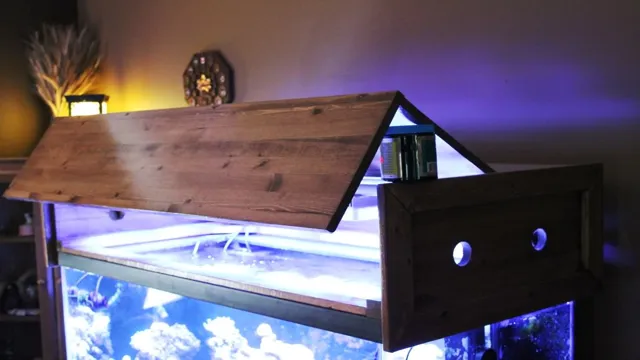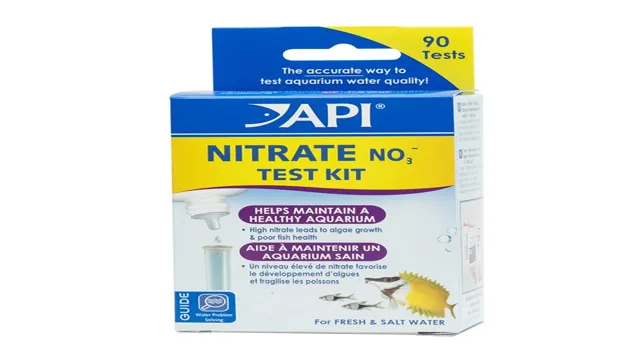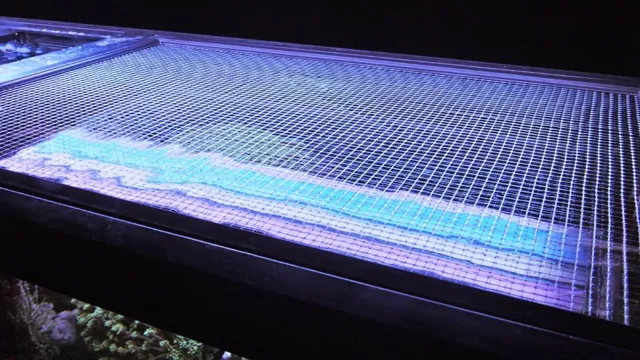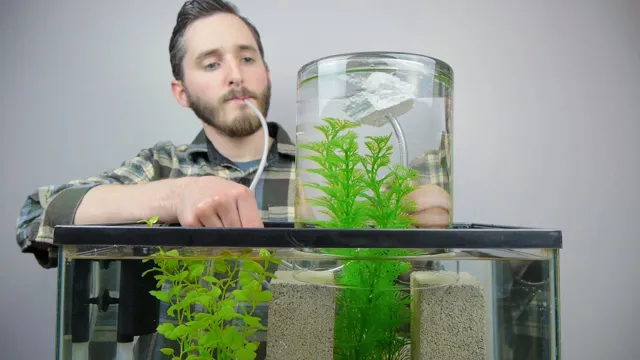Have you ever thought about building your own aquarium hood out of wood? Not only is it a fun DIY project but it can also save you money and give your aquarium a unique touch. In this article, we will show you step-by-step how to build a wooden aquarium hood that is both functional and looks great. Whether you’re a seasoned woodworker or a beginner, this tutorial is easy to follow and can be adapted to fit any aquarium size and shape.
So, roll up your sleeves, grab your tools, and let’s get started on creating a custom wooden aquarium hood that will impress all your fish-keeping friends!
Tools and Materials
Are you wondering how to build a wooden aquarium hood? Well, you’re in luck! Building a wooden hood for your aquarium is easier than you might think. To get started, you’ll need some basic tools and materials such as a saw, drill, screws, wood glue, and of course, wood. You’ll also need to measure the dimensions of your aquarium to ensure that your hood fits perfectly.
Once you have your materials and measurements, you can start building your wooden aquarium hood. It’s important to make sure that your hood is sturdy enough to support any lighting or other equipment you may have on top of it. You can also get creative with your design by adding decorative elements like a carved pattern or a stain finish.
With a little effort, your wooden aquarium hood will not only look great, but it will also help create a healthy environment for your aquatic pets. So, why not give it a try?
Tools Needed:
If you’re planning to start a new DIY project, you’re going to need some tools and materials to get the job done. The specific tools you’ll need will depend on the project you’re working on, but there are a few basics that every DIYer should have in their kit. A hammer, screwdrivers, pliers, a level, and a tape measure are all essential tools that you’ll use over and over again.
Other useful tools might include a power drill, saw, and sandpaper. Before you start your project, make sure you have all the tools you need on hand. It can be frustrating to get halfway through a project and realize you don’t have the right tool to finish the job.
With the right tools and materials, you’ll be well on your way to completing your DIY project successfully!
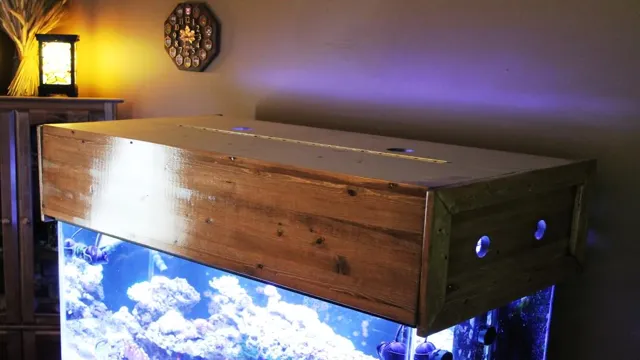
– Saw, drill, screwdriver, sandpaper, measuring tape
Tools and materials are essential components for any DIY project, whether you’re a seasoned pro or a complete novice. Among the basic tools needed are a saw, drill, screwdriver, sandpaper, and measuring tape. A saw is handy for cutting pieces of wood, metal, or plastic to size while a drill is perfect for making holes or assembling components.
A screwdriver is used to tighten or loosen screws, while sandpaper helps smoothen rough edges or surfaces. Measuring tape is necessary to ensure precise measurements, which guarantees the correct length or width of materials needed to be cut or assembled. As you progress through your DIY projects, you’ll need a more specialized set of tools, but these basic tools are essential in any DIY toolbox.
Remember, the right tool makes all the difference. Investing in quality and durable tools will not only make your DIY experience more enjoyable but also save you time and money in the long run.
Materials Needed:
When it comes to starting a new DIY project, having the right tools and materials is crucial to success. Depending on the project you have in mind, you may need a variety of hand tools, power tools, and materials to get the job done right. Some common tools you may need include a drill, saws, screws, a hammer, and measuring tools such as a level or tape measure.
Other materials you may need can vary based on the specific project, but may include items such as lumber, paint, sandpaper, or nails. It’s important to take stock of what you already have on hand and determine what additional tools and materials you’ll need before starting your project. By doing so, you can avoid last-minute trips to the hardware store and ensure that you have everything you need to get the job done right.
– Plywood, wood glue, screws, hinges, handles
When it comes to building furniture, having the right tools and materials is crucial. Plywood, with its strength and durability, is an excellent choice for many furniture projects. Wood glue ensures a strong and stable bond between pieces, while screws offer additional reinforcement.
Hinges and handles allow for functional features and easy access. To put it all together, you’ll need a variety of tools, including a drill, saw, sandpaper, and measuring tools. Don’t forget safety equipment like goggles and gloves to protect yourself during the building process.
With these materials and tools, you’ll have everything you need to create beautiful and practical furniture pieces for your home. So, are you ready to get started on your next DIY project?
Design the Hood
If you’re looking to build a wooden aquarium hood, the first step is designing the hood. You’ll want to consider the size of your aquarium, the type of lighting you want to use, and any additional features you may want, such as a feeding hole or a ventilation system. When designing the hood, it’s important to ensure that it fits snugly over the top of your aquarium and doesn’t obstruct any filters or other equipment.
You’ll also want to consider the type of wood you want to use- hardwoods like oak, maple, or cherry are sturdy and long-lasting, but can be expensive. Softwoods like pine or cedar are more affordable but may not be as durable. Ultimately, the design of your wooden aquarium hood will depend on your preferences and the specific needs of your aquarium setup.
But by taking the time to design the hood carefully, you’ll be able to create a beautiful and functional addition to your aquarium that will provide proper lighting and protection for your fish.
Measure the Aquarium:
When designing the hood for your aquarium, it is important to consider the size and shape of the tank. Measure the top of the aquarium carefully to ensure that the hood fits snugly and securely. Remember to account for any filters or other equipment that may be attached to the tank.
The hood should cover the entire top of the aquarium, providing proper lighting and ventilation. One important consideration is the material used to make the hood. It should be durable and able to withstand the humidity and moisture present in an aquarium environment. (See Also: How to Make an Aquarium for a Turtle: A Step-by-Step Guide For Beginners)
There are a variety of materials that can be used, such as plastic, glass, or acrylic. Choose a material that is easy to clean and maintain, and that can accommodate any necessary fixtures or attachments for lighting and ventilation. Designing a hood for your aquarium can be a fun and creative process, but it requires careful planning and attention to detail.
With the right materials and measurements, you can create a beautiful and functional hood that enhances the look and health of your aquatic environment.
– Measure the length and width of the aquarium
When designing the hood for your aquarium, the first step is to measure the length and width of the tank. This will give you the exact dimensions you need to create an appropriate hood. When creating the hood, it’s important to consider the type of fish and plants you have in your tank, as well as the amount of light they need.
You may also want to consider the color and material of the hood, as well as any additional features, such as a feeding hole or ventilation. By taking these factors into account, you can ensure that your aquarium hood is not only functional but also visually appealing. A well-designed hood can help to improve the health and happiness of your aquatic pets, as well as enhance the overall aesthetic of your living space.
So, take your time and design a hood that meets both your needs and the needs of your fish.
Create a Blueprint:
When designing the hood for your blueprint, there are several factors to consider. The style and function of the hood will determine how it fits into your overall design. One important element is the placement of the hood vent.
This can affect the efficiency of the hood, as well as the visual aesthetic. Another consideration is the type of material used for the hood. Stainless steel is a popular choice due to its durability and ease of cleaning, but other options such as copper or brass can add a unique touch to your kitchen.
Finally, the size of the hood should be proportionate to the size of your cooking surface. A hood that is too small may not effectively capture smoke and steam, while a hood that is too large may overpower the space. By carefully considering these elements, you can design a hood that not only works efficiently but also adds a stylish statement to your kitchen.
– Create a blueprint with measurements and angles for the hood
Designing a custom hood for your kitchen is a fun and exciting project that can transform the entire look and feel of your space. To ensure that the hood fits perfectly into your kitchen, it’s important to create a blueprint with precise measurements and angles. This blueprint will serve as a guide for you or your contractor during the installation process and will ensure that the hood is both functional and aesthetically pleasing.
When creating the blueprint, take into consideration the size and shape of your stove, the height of your ceiling, and the overall style of your kitchen. By carefully designing the hood, you can create a unique and stylish feature that not only adds value to your home but also allows you to cook with ease and comfort. So why not get creative and design a hood that will make your kitchen the envy of all your friends and family?
Building the Hood
If you’re looking to add a wooden aquarium hood to your setup, you’re in luck – it’s relatively simple to do! First, you’ll want to measure the top of your aquarium to get a sense of how large the hood should be. Then, gather your materials – you’ll need plywood, wood stain, and a saw. Cut the plywood to the appropriate size for your tank, and sand it down to ensure it’s smooth.
Apply the wood stain in the color of your choice, and let it dry completely. Once the stain is dry, you can affix the hood to your aquarium using hinges. This will allow you to easily lift the hood on and off for feeding and maintenance.
And there you have it – a beautiful, functional wooden aquarium hood that will make your tank stand out!
Cutting the Wood:
When building a hood, the first step is cutting the wood to the appropriate size and shape. This requires careful measurement and precision cuts to ensure that all pieces fit together properly. It’s important to use high-quality lumber that will withstand the heat and moisture that a hood will be exposed to.
Hardwoods like oak, maple, and cherry are good choices for their durability and resistance to warping. Once the wood has been cut, it’s important to sand and smooth the edges to ensure a tight fit when assembling the hood. Don’t forget to label each piece to make assembly easier later on.
With the proper tools and attention to detail, cutting the wood for your hood can be a satisfying and enjoyable part of the building process.
– Use a saw to cut the plywood according to the blueprint
Building the Hood of a kitchen range involves cutting the plywood according to the blueprint using a saw. This step is critical to ensure the precision and accuracy of the hood’s final shape and size. It is best to use a circular saw as it can easily cut through thick plywood without any problem.
Before starting the cutting process, you should first check if the saw blade is sharp and in good condition to avoid any accidents. It is also essential to secure the plywood on a stable surface using clamps to prevent it from moving while you cut. It is advisable to follow the blueprint’s measurements carefully, ensuring that every cut is accurate, so the pieces fit together perfectly.
After cutting all the boards, you can start assembling the hood’s frame using wood screws, glue, and clamps. This will ensure that the hood is sturdy and durable enough to hold the weight of the vent hood fan and ductwork. Building a kitchen range hood may seem like a challenging task, but with the correct tools and proper blueprint, anyone can accomplish this DIY project. (See Also: How to Maintain a Reef Aquarium: Tips and Tricks for a Healthy Underwater Ecosystem)
Assembly:
Assembling the hood of your car can be a tricky process, but with patience and attention to detail, it’s definitely a task anyone can take on. There are a few steps you’ll need to follow to make sure the hood is properly installed. The first step is to align the hood to the hinges so that it properly lines up with the car body and front bumper.
Once this is done, you’ll need to adjust the latch so that it fits snugly under the hood. Finally, attach the hydraulic lifts to the hood to ensure that it opens and closes smoothly. It’s important to take your time and carefully follow each of these steps to ensure that your hood functions properly and looks great.
Remember, a well-built hood can not only improve your car’s appearance but also help to protect your engine from damage caused by weather and debris. Don’t hesitate to seek professional advice if you’re unsure about anything.
– Use wood glue and screws to assemble the hood
When it comes to building a hood for your kitchen, there are many materials and techniques that you can use. One popular option is to use wood glue and screws to assemble the hood. This method is relatively simple and can produce a sturdy and durable hood that can withstand the heat, moisture, and wear and tear of everyday use.
To begin, you will need to gather the necessary materials, including wood glue, screws, and wood boards. Once you have your materials ready, you can start by cutting the wood boards to the desired size and shape of your hood. Then, you can apply the wood glue to the edges of the boards and attach them together using screws.
Be sure to use clamps or other tools to keep the boards in place while the glue dries. Once the hood is assembled, you can sand and finish it to give it a smooth surface and a polished look. With a little bit of patience and effort, you can create a beautiful and functional hood for your kitchen that will last for years to come.
– Attach hinges and handles for easy access
When building a hood for your kitchen, attaching hinges and handles is an important step for easy access. Installing hinges will allow for easy opening and closing of the hood, making it easier to clean and maintain. You can attach the hinges to the back of the hood and the wall, ensuring that it is secure and won’t move around.
Adding handles on the side of the hood can also make it easier to access and adjust while cooking. Additionally, the handles can be used to lift and remove the hood for cleaning purposes. Make sure to choose sturdy handles that can support the weight of the hood without breaking.
By installing hinges and handles, you will have a functional and easily accessible hood for your kitchen.
Finishing Touches
Building the perfect wooden aquarium hood is a great way to upgrade your fish tank and add a touch of style. Once you’ve completed the main construction, it’s time to add the finishing touches. One of the first steps is to sand the entire hood to create a smooth finish.
Next, you’ll want to paint or seal the hood to protect it from moisture and extend its lifespan. A high-quality sealant or paint will also help the hood blend in with your decor and look great for years to come. Finally, consider adding some additional accents or decorations to the hood, such as brass handles or a matching trim, to really make it stand out.
By taking your time and putting in a little effort, you can create a wooden aquarium hood that will be the envy of all your guests.
Sand the Edges:
When it comes to woodworking and DIY projects, sanding the edges is an essential finishing touch that can make all the difference in the final product. It’s important to smooth out any rough edges or splinters that may have been left over from cutting or shaping the wood. This not only makes the piece look more polished and professional, but it also helps to prevent any potential injuries or damage to the wood.
To get the best results, it’s recommended to use a sandpaper with a fine grit, such as 220, and to sand in a consistent and even motion along the edges. You can also use a sanding block to ensure even pressure and to keep your hands safe from any sharp edges. Once you’ve sanded down the edges, make sure to wipe away any dust or debris with a clean rag or brush before moving on to the next step.
By taking the time to sand the edges, you’ll be able to create a beautiful and functional piece that you can be proud of.
– Sand the edges of the plywood to smooth them out
When it comes to putting together a plywood project, ensuring a smooth and polished finish is crucial. One easy way to achieve this is by sanding the edges of the plywood. Sanding helps to smooth out any rough or uneven edges, creating a seamless surface that not only looks great but is also safe to handle.
It’s important to use the right type of sandpaper and to sand in the direction of the wood grain to avoid leaving scratch marks or damaging the plywood. By taking the time to finish off your project in this way, you’ll be left with a professional-looking product that will stand the test of time. So don’t skip this important step, grab your sandpaper and get started on those edges today!
Paint or Stain:
When it comes to adding the finishing touches to your home renovation or DIY project, choosing between paint or stain can be a tough decision. Both options have their own unique advantages and disadvantages depending on the type of surface and desired look. If you’re looking for a smooth, consistent finish that covers imperfections, then paint may be the best choice for you.
It can give an entirely new look to your space, covering up old stains or uneven coloring. However, it can also require more upkeep and maintenance as it can chip and peel over time. On the other hand, if you want to highlight the natural beauty of wood grain or other materials, then stain is the way to go.
Stain allows the natural grain to shine through and can add depth and character to your space. Stain is also typically more durable and long-lasting than paint, making it a great choice for high-traffic areas. Ultimately, the decision comes down to personal preference and your specific project needs. (See Also: How to Make an Aquarium Look New Again: Top Tips and Tricks)
Consider factors such as the surface you’re working with, the desired look, and the level of upkeep you’re willing to commit to. By weighing your options and researching different products, you can make an informed decision and add the perfect finishing touch to your project.
– Paint or stain the hood to protect it from moisture and give it a finished look
When it comes to adding a finishing touch to your kitchen, painting or staining your range hood can make a big difference. Not only does it protect your hood from moisture and give it a more polished look, but it also ties together the overall design of the space. Depending on your kitchen’s style, you can go for a bold color to make a statement or stick to a natural wood stain for a more traditional look.
Before you start painting or staining, be sure to properly clean and prepare the surface to ensure the best results. Additionally, make sure to select a paint or stain that’s specifically formulated for use on metal surfaces, and always apply in a well-ventilated area. With the right finish, your range hood can be the perfect final touch to your dream kitchen.
Conclusion
In conclusion, building a wooden aquarium hood may seem daunting, but it’s a rewarding and cost-effective way to give your fish tank a stylish upgrade. Just remember to measure twice, cut once, and always keep safety in mind. With a little patience, some basic woodworking skills, and a touch of creativity, you’ll have a beautiful, bespoke hood that will make all your fishy friends jealous.
And who knows, you may even inspire others in the aquarium community to take up woodworking as a new hobby! So get those tools ready, dive into the blueprints, and let your imagination run wild – the possibilities are endless. Happy fishing and happy building!”
Building a wooden aquarium hood can be a fun and rewarding project that adds both practicality and style to your aquarium. With the right tools and materials, and a little bit of planning, anyone can create a beautiful and functional hood for their aquarium.
When it comes to building a wooden aquarium hood, the finishing touches can really make it stand out. First, consider how you want to treat the wood. Staining can enhance the natural grain of the wood, while painting allows for a wider range of colors and finishes.
Whichever you choose, make sure it’s aquarium-safe and won’t harm your fish or aquatic plants. Next, think about lighting. Adding LED strips or individual lights can highlight your tank’s features and create a beautiful ambiance.
You can also add decorative elements like trim, knobs, or handles to give it a professional look. Finally, don’t forget about ventilation. Make sure your hood allows for air to circulate to prevent moisture buildup and ensure your tank stays healthy and clear.
By paying attention to these finishing touches, your wooden aquarium hood can become an impressive centerpiece of your home.
FAQs
What materials do I need to build a wooden aquarium hood?
You will need plywood, wood screws, hinges, drill, saw, and wood stain or paint.
How much time will it take to build a wooden aquarium hood?
The time required will depend on your woodworking skills. It may take a few hours to a few days to build a wooden aquarium hood.
Can I seal the wooden aquarium hood to make it waterproof?
Yes, you can use a waterproof sealer or paint for wooden aquarium hoods to protect it from water damage.
Can I modify the size and shape of the wooden aquarium hood to fit my tank?
Yes, you can modify the size and shape of the wooden aquarium hood according to the size and shape of your aquarium.
Do I need any special tools to build a wooden aquarium hood?
You will need basic woodworking tools like a drill, saw, and screwdriver to build a wooden aquarium hood.
Do I need any prior woodworking experience to build a wooden aquarium hood?
It’s good to have some woodworking experience to build a wooden aquarium hood, but with proper guidance or instructions, anyone can do it.
How can I maintain the wooden aquarium hood?
You can maintain the wooden aquarium hood by cleaning it regularly, keeping it dry, and applying a coat of sealant or paint every year.

